User:Shakescene/NYMayorsList
The Mayor of New York City is the chief executive of the government of New York City, as stipulated by the Charter of the City of New York. The current Mayor of New York City, the 109th in the sequence of regular mayors, is Bill de Blasio, a Democrat.
During the Dutch colonial period from 1624 to 1664, New Amsterdam was governed by the Director of New Netherland. The office of Mayor of New York was established in 1665 and were appointed by colonial governors until 1777. The year prior, New York was run by Richard Nicolls, the British military governor of the Province of New York. Thomas Willett was the first person to be specifically appointed mayor.
In 1777, during the American Revolution, a Council of Appointment was formed by New York State. In 1821 the New York City Council – then known as the Common Council – began appointing mayors.
Since 1834, mayors have been elected by direct popular vote.[citation needed]
Before 1898, the city included little beyond the island of Manhattan. The 1898 consolidation created the city as it is today with five boroughs: Manhattan, the Bronx, Brooklyn, Queens, and Staten Island.
The longest-serving mayors have been Fiorello H. La Guardia (1934–1945), Robert F. Wagner, Jr. (1954–1965), Ed Koch (1978–1989), and Michael Bloomberg (2002–2013) each of whom was in office for twelve years (three successive 4-year terms). The shortest terms in office since 1834 have been those of acting mayors: Thomas Coman (five weeks from Monday, November 30, 1868, to Monday, January 4, 1869) and Samuel B. H. Vance (one month from November 30 to December 31, 1874), in addition to the purely nominal single day that William T. Collins served in 1925.
Every mayor so far, with the solitary exception of David Dinkins from 1990 to 1993, has been a non-Hispanic white man. Mayors have come from a variety of ethnic groups and held a variety of religions.[citation needed]
Colonial mayors
[edit]Before 1680, mayors served one-year terms. As of 1680, they served two-year terms. Exceptions are noted thus (*). A dagger (†) indicates mayoralties cut short by death in office. [When the same man served more than one continuous term, his name is lightly shaded purely for clarity, but the tints have no other significance.]
| No.[1] | Name | Starting year of Office | Ending year of Office |
|---|---|---|---|
| 1 | Thomas Willett (1st term) | 1665 | 1666 |
| 2 | Thomas Delavall (1st term) | 1666 | 1667 |
| 3 | Thomas Willett (2nd term) | 1667 | 1668 |
| 4 | Cornelius Van Steenwyk (1st term) | 1668 | 1671 |
| 5 | Thomas Delavall (2nd term) | 1671 | 1672 |
| 6 | Matthias Nicoll | 1672 | 1673 |
| 7 | John Lawrence (1st term) | 1673 | 1675 |
| 8 | William Dervall | 1675 | 1676 |
| 9 | Nicholas De Mayer | 1676 | 1677 |
| 10 | Stephanus Van Cortlandt (1st term) | 1677 | 1678 |
| 11 | Thomas Delavall (3rd term) | 1678 | 1679 |
| 12 | Francis Rombouts | 1679 | 1680 |
| 13 | William Dyre | 1680 | 1682 |
| 14 | Cornelius Van Steenwyk (2nd term) | 1682 | 1684 |
| 15 | Gabriel Minvielle (*) | 1684 | 1685 |
| 16 | Nicholas Bayard (*) | 1685 | 1686 |
| 17 | Stephanus Van Cortlandt (2nd term) | 1686 | 1688 |
| 18 | Peter Delanoy 1 | 1689 | 1691 |
| 19 | John Lawrence (2nd term *) | 1691 | 1691 |
| 20 | Abraham de Peyster | 1691 | 1694 |
| 21 | Charles Lodwik | 1694 | 1695 |
| 22 | William Merritt | 1695 | 1698 |
| 23 | Johannes de Peyster | 1698 | 1699 |
| 24 | David Provost | 1699 | 1700 |
| 25 | Isaac De Reimer | 1700 | 1701 |
| 26 | Thomas Noell | 1701 | 1702 |
| 27 | Phillip French | 1702 | 1703 |
| 28 | William Peartree | 1703 | 1707 |
| 29 | Ebenezer Wilson | 1707 | 1710 |
| 30 | Jacobus Van Cortlandt (1st term) | 1710 | 1711 |
| 31 | Caleb Heathcote | 1711 | 1714 |
| 32 | John Johnstone | 1714 | 1719 |
| 33 | Jacobus Van Cortlandt (2nd term) | 1719 | 1720 |
| 34 | Robert Walters | 1720 | 1725 |
| 35 | Johannes Jansen | 1725 | 1726 |
| 36 | Robert Lurting † | 1726 | 1735 |
| 37 | Paul Richard | 1735 | 1739 |
| 38 | John Cruger † | 1739 | 1744 |
| 39 | Stephen Bayard | 1744 | 1747 |
| 40 | Edward Holland † | 1747 | 1757 |
| 41 | John Cruger, Jr. | 1757 | 1766 |
| 42 | Whitehead Hicks | 1766 | 1776 |
| 43 | David Matthews | 1776 | 1783 |
Note
- Peter Delanoy was the first and only directly-elected mayor of New York[2] until 1834. Appointed mayors resumed in the wake of Leisler's Rebellion.
† died in office
Pre-consolidation mayors
[edit]After 1820, the mayor was appointed by the city's Common Council. Under the Charter of 1834, mayors were elected annually. After 1849, they served two-year terms.
| # | Mayor | Term start | Term end | Terms | ||
|---|---|---|---|---|---|---|
| 44 | James Duane | January 1, 1784 | 1789 | 5 | None | |
| 45 | Richard Varick | 1789 | 1801 | 2 | Federalist | |
| 46 | Edward Livingston | 1801 | 1803 | 2 | Democratic-Republican | |
| 47 | DeWitt Clinton (1st term) | 1803 | 1807 | 4 | Democratic-Republican | |
| 48 | Marinus Willett | 1807 | 1808 | 1 | Democratic-Republican[3] | |
| 49 | DeWitt Clinton (2nd term) | 1808 | 1810 | 2 | Democratic-Republican | |
| 50 | Jacob Radcliff (1st term) | 1810 | 1811 | 1 | Federalist | |
| 51 | DeWitt Clinton (3rd term) | 1811 | 1815 | 4 | Democratic-Republican | |
| 52 | John Ferguson | 1815 | 1815 | 1⁄2 | Democratic-Republican | |
| 53 | Jacob Radcliff (2nd term) | 1815 February 13 | 1818 | 3 | Federalist | |
| 54 | Cadwallader D. Colden | 1818 | 1821 | 3 | Federalist | |
| 55 | Stephen Allen | 1821 | 1824 | 3 | Federalist | |
| 56 | William Paulding Jr. (1st term) | 1825 | 1826 | 1 | Democratic-Republican | |
| 57 | Philip Hone | 1826 | 1827 | 1 | National Republican | |
| 58 | William Paulding Jr. (2nd term) | 1827 | 1829 | 2 | Democratic-Republican | |
| 59 | Walter Bowne | 1829 | 1832 | 3 | Democratic | |
| 60 | Gideon Lee | 1833 | 1834 | 1 | Democratic | |
| 61 | Cornelius Lawrence | 1834 | 1837 | 3 | Democratic | |
| 62 | Aaron Clark | 1837 | 1839 | 2 | Whig | |
| 63 | Isaac L. Varian | 1839 | 1841 | 2 | Democratic | |
| 64 | Robert H. Morris | 1841 | 1844 | 3 | Democratic | |
| 65 | James Harper | 1844 | 1845 | 1 | American Republican | |
| 66 | William F. Havemeyer (1st term) | 1845 | 1846 | 1 | Democratic | |
| 67 | Andrew H. Mickle | 1846 | 1847 | 1 | Democratic | |
| 68 | William V. Brady | 1847 | 1848 | 1 | Whig | |
| 69 | William F. Havemeyer (2nd term) | 1848 | 1849 | 1 | Democratic | |
| 70 | Caleb S. Woodhull | 1849 | 1851 | 1 | Whig | |
| 71 | Ambrose Kingsland | 1851 | 1853 | 1 | Whig | |
| 72 | Jacob A. Westervelt | 1853 | 1855 | 1 | Democratic | |
| 73 | Fernando Wood (1st term) | 1855 | 1858 | 2 | Democratic | |
| 74 | Daniel F. Tiemann | 1858 | 1860 | 1 | American | |
| 75 | Fernando Wood (2nd term) | 1860 | 1862 | 1 | Democratic | |
| 76 | George Opdyke | 1862 | 1864 | 1 | Republican | |
| 77 | Charles G. Gunther | 1864 | 1866 | 1 | Democratic | |
| 78 | John T. Hoffman1 | 1866 | 1868 November 30 | less than 1 | Democratic | |
| Acting | Thomas Coman 1 | 1868 November 30 | 1869 January 4 | 5 weeks | Democratic | |
| 79 | Abraham Oakey Hall | 1869 January 4 | 1872 December 31 | 1 | Republican | |
| 80 | William F. Havemeyer 2(3rd term) † | 1873 January 1 | 1874 November 30 | less than 1 | Republican | |
| Acting | Samuel B. H. Vance 2 | 1874 November 30 | 1874 December 31 | 1 month | Republican | |
| 81 | William H. Wickham | 1875 January 1 | 1876 December 31 | 1 | Democratic (Reform) | |
| 82 | Smith Ely Jr. | 1877 | 1878 | 1 | Democratic | |
| 83 | Edward Cooper | 1879 | 1880 | 1 | Democratic (Reform) | |
| 84 | William R. Grace (1st term) | 1881 | 1882 | 1 | Democratic (Reform) | |
| 85 | Franklin Edson | 1883 | 1884 | 1 | Democratic | |
| 86 | William R. Grace (2nd term) | 1885 | 1886 | 2 | None | |
| 87 | Abram Hewitt | 1887 | 1888 | 1 | Democratic | |
| 88 | Hugh J. Grant | 1889 | 1892 | 2 | Democratic | |
| 89 | Thomas F. Gilroy | 1893 | 1894 | 1 | Democratic | |
| 90 | William L. Strong 3 | 1895 January 1 | 1897 December 31 | 1 (3 years) |
Republican |
Notes
- John T. Hoffman resigned after his election as Governor of New York state but before the end of his mayoral term.[4] Thomas Coman, President of the Board of Aldermen, completed Hoffman's term as acting mayor until his elected successor, A. Oakey Hall, took office.[5]
- William F. Havemeyer died during his last term of office. Samuel B. H. Vance, President of the Board of Aldermen, completed Havemeyer's term as acting mayor until his elected successor, William H. Wickham, took office.
- William L. Strong served an additional year in office because New York City mayoral elections were changed to be held in odd-numbered years due to the impending consolidation of New York City.
† died in office
Post-consolidation mayors
[edit]The 1898–1901 term was for four years. The City Charter was changed to make the mayor's term a two-year one beginning in 1902, but after two such terms was changed back to resume four-year terms in 1906. George B. McClellan, Jr. thus served one two-year term from 1904 to 1905, during which he was elected to a four-year term from 1906 to 1909. See New York City mayoral elections#Terms and term limits (since 1834).
The party of the mayor reflects party registration, as opposed to the party lines run under during the general election.
| #[1] | Portrait | Name | Term in office | Length of Service | Party affiliation | Previous office | |
|---|---|---|---|---|---|---|---|
| 91 | 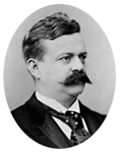
|
Robert A. Van Wyck (1849–1918; aged 69) |
January 1, 1898 – December 31, 1901 |
4 years | Democratic | None | |
| 92 | 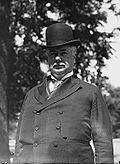
|
Seth Low 1 (1850–1916; aged 66) |
January 1, 1902 – December 31, 1903 |
2 years | Republican | 11th President of Columbia University (1890–1901) | |
| 93 | 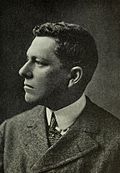
|
George B. McClellan Jr. (1865–1940; aged 75) |
January 1, 1904 – December 31, 1909 |
6 years | Democratic | U.S. Representative for New York (1895–1903) | |
| 94 | 
|
William Jay Gaynor 2 † (1849–1913; aged 64) |
January 1, 1910 – September 10, 1913 |
3 years, 253 days | Democratic | Judge to the New York Supreme Court (1893–1909) | |
| Acting2 | 
|
Ardolph L. Kline | September 10, 1913 – December 31, 1913 |
113 days | Republican | President of Board of Aldermen | |
| 95 | 
|
John P. Mitchel (1879–1918; aged 38) |
January 1, 1914 – December 31, 1917 |
4 years | Republican | U.S. Customs Collector of the Port of New York; President of Board of Aldermen | |
| 96 | 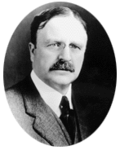
|
John F. Hylan[6] (1868–1936; aged 67) |
January 1, 1918 – December 30, 1925 |
8 years | Democratic | None | |
| Acting | William T. Collins | December 31, 1925[6] | 1 day | Democratic | |||
| 97 | 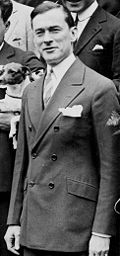
|
Jimmy Walker 3 (1881–1946; aged 65) |
January 1, 1926 – September 1, 1932 |
6 years, 244 days | Democratic | New York State Senator (1919–1925) | |
| Acting3 | 
|
Joseph V. McKee | September 1, 1932 – December 31, 1932 |
121 days (4 months) |
Democratic | President of theCity Council | |
| 98 | John P. O'Brien (1873–1951; aged 78) |
January 1, 1933 – December 31, 1933 |
1 year | Democratic | None | ||
| 99 | 
|
Fiorello H. La Guardia (1882–1947; aged 64) |
January 1, 1934 – December 31, 1945 |
12 years | Republican[7] | U.S. Representative for New York (1922–1933) | |
| 100 | 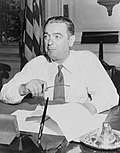
|
William O'Dwyer 4 (1890–1964; aged 74) |
January 1, 1946 – August 31, 1950 |
4 years, 243 days (4 years, 8 months) |
Democratic | Brooklyn District Attorney (1939–1945) | |
| Acting5 | 
|
Vincent R. Impellitteri5 (1900–1987; aged 86) |
August 31, 1950 – November 14, 1950 |
75 days | Democratic (as acting mayor) |
President of the City Council (1945–1949) | |
| 101 | November 14, 1950 – December 31, 1953 |
3 years, 48 days | Experience Party as elected mayor |
Acting Mayor | |||
| 102 | 
|
Robert F. Wagner Jr. (1910–1991; aged 80) |
January 1, 1954 – December 31, 1965 |
12 years | Democratic | 17th Borough President of Manhattan (1950–1953) | |
| 103 | 
|
John Lindsay (1921–2000; aged 79) |
January 1, 1966 – December 31, 1973 |
8 years | Republican | U.S. Representative for New York (1959–1965) | |
| Democratic | |||||||
| 104 | 
|
Abraham Beame (1906–2001; aged 94) |
January 1, 1974 – December 31, 1977 |
4 years | Democratic | 38th New York City Comptroller (1970–1973) | |
| 105 | 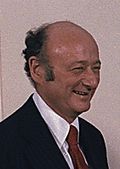
|
Ed Koch (1924–2013; aged 88) |
January 1, 1978 – December 31, 1989 |
12 years | Democratic | U.S. Representative for New York (1973–1977) | |
| 106 | 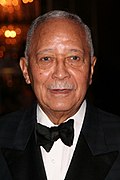
|
David Dinkins (born in 1927; aged 89) |
January 1, 1990 – December 31, 1993 |
4 years | Democratic | 23rd Borough President of Manhattan (1986–1989) | |
| 107 | 
|
Rudy Giuliani (born in 1944; aged 72) |
January 1, 1994 – December 31, 2001 |
8 years | Republican | United States Attorney for the Southern District of New York (1983–1989) | |
| 108 | 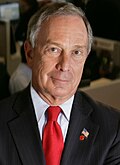
|
Michael Bloomberg 6 (born in 1942; aged 74) |
January 1, 2002 – December 31, 2013 |
12 years | Republican | CEO of Bloomberg L.P. (1981–2001) | |
| None | |||||||
| 109 | 
|
Bill de Blasio (born in 1961; aged 55) |
January 1, 2014 – Incumbent |
4 years | Democratic | 3rd New York City Public Advocate (2010–2013) | |
Notes
- Seth Low previously served as Mayor of the City of Brooklyn from 1882 to 1885.
- William Jay Gaynor died September 10, 1913. Ardolph L. Kline, the unelected President of the Board of Aldermen, succeeded as acting mayor upon William Gaynor's death, but then sought re-election as an alderman (successfully) rather than election as mayor. Kline has thus been the only mayor since 1834 never to win a city-wide election (having been appointed Vice President of the Board of Aldermen by his colleagues and then succeeding to the presidency mid-term, rather than winning it by popular election at large).
- James J. "Jimmy" Walker resigned September 1, 1932 and went to Europe, amid allegations of corruption in his administration. Joseph V. McKee, as President of the Board of Aldermen, became acting mayor in Walker's place, but was then defeated in a special election by John P. O'Brien.
- William O'Dwyer resigned August 31, 1950, during a police corruption scandal, after which he was appointed Ambassador to Mexico by President Harry S. Truman.
- Vincent R. Impellitteri, President of the New York City Council, became acting mayor when O'Dwyer resigned on August 31, 1950, and was then elected to the office in a special election held on November 7, 1950. He was inaugurated on November 14.
- Michael R. Bloomberg was a Democrat before running for mayor.
† died in office
See also
[edit]- Election results for Mayor of New York
- History of New York City
- Mayors of the City of Brooklyn (1834–98)
References
[edit]- ^ a b "The Green Book: Mayors of the City of New York" on the official NYC website. When a former mayor serves again after a break in office, a new number is assigned to his resumed service. However, the six acting mayoralties are unnumbered.
- ^ Burrows, Edwin G. and Wallace, Mike (1999). Gotham: A History of New York City to 1898. New York: Oxford University Press. ISBN 0-195-11634-8. pp.99–100
- ^ John Caldwell; Oswaldo Rodriguez Roque; Dale T. Johnson (March 1, 1994). American Paintings in The Metropolitan Museum of Art. Vol. 1. Metropolitan Museum of Art. p. p.256.
{{cite book}}:|page=has extra text (help) - ^ "Local Intelligence — Board of Aldermen — Resignation of the Mayor". New York Times. November 17, 1868. p. 2. Retrieved December 15, 2016.
- ^ "Municipal Affairs — Organization of the Common Council — The Mayor's Message — The City Budget for 1869 — Comparison of Taxation in 1868 and 1869". New York Times. January 5, 1869. p. 2. Retrieved December 15, 2016.
- ^ a b "Hylan And Enright Out With Pensions; Last-Hour Shifts In Police Department; Walker Fills Important City Posts - Collins Mayor for a Day - Leach is the Active Head of the Police Force for the Last Day of 1925 - Hylan to Get $4,205 A Year - Retirement Voted by Board of Estimate, He Quits to Assure Pension - Enright to Draw $5,000 - Approval of His Retirement as Commissioner One of Hylan's Last Official Acts". New York Times. December 31, 1925. p. 1. Retrieved August 19, 2016.
- ^ "List of Candidates Who Will Be on Ballots in Municipal Election Nov. 7". New York Times. November 5, 1933. p. N2. Retrieved August 19, 2016.
External links
[edit] Media related to Mayors of New York City at Wikimedia Commons
Media related to Mayors of New York City at Wikimedia Commons
Category:Mayors of New York City New York City
Part II
[edit]Intro
[edit]The Mayor of New York City is the chief executive of the government of New York City, as stipulated by the Charter of the City of New York.
This list includes mayors who governed the city of New York at times when its territory was smaller than it is today. Before 1874, the city covered little or no land beyond the island of Manhattan, but later annexed territory in the area that formed the Borough of the Bronx in 1898. The city's consolidation in 1898 defined the current boundaries of the five boroughs: Manhattan, the Bronx, Brooklyn, Queens and Staten Island. See History of New York City.
The current Mayor of New York City, (and 109th in the sequence of regular mayors), is Bill de Blasio, a Democrat.
During the Dutch colonial period from 1625 to 1664, New Amsterdam was governed by a Director-General. For the year prior to the establishment of the office of Mayor of New York in 1665, New York was run by Richard Nicolls, who was the British military governor of the Province of New York. Thomas Willett was the first person to be specifically appointed mayor.
Mayors were appointed by provincial governors until 1777 when a Council of Appointment was formed by New York State. In 1821 the New York City Council – then known as the Common Council – began appointing mayors. Since 1834 mayors have been elected by direct popular vote.
The longest-serving mayors so far have been Fiorello H. La Guardia (1934–1945), Robert F. Wagner, Jr. (1954–1965), Edward I. Koch (1978–1989), and Michael Bloomberg (2002–2013) each of whom was in office for twelve years (three successive 4-year terms). The shortest terms in office since 1834 have been those of acting mayors Thomas Coman (five weeks from Monday, November 30, 1868, to Monday, January 4, 1869) and Samuel B. H. Vance (one month from November 30 to December 31, 1874).
Although being Mayor of New York City has been described as the "second toughest job in America" after the Presidency,[1] and although several mayors – most recently John Lindsay and Rudolph Giuliani – have sought the Presidency, no one person has yet held both positions. Indeed no sitting or former mayor has been elected to another public office since Ardolph Loges Kline (acting mayor in late 1913) was re-elected Alderman in 1913 and later elected in 1920 to his only term in Congress. Neither has any mayor so far (out of more than a hundred) been female, nor has any except David Dinkins been non-white.
Notes
[edit]Notes:
- Seth Low previously served as Mayor of the City of Brooklyn from 1882 to 1885.
- William Jay Gaynor died September 10, 1913.
- Ardolph L. Kline, the unelected President of the Board of Aldermen, succeeded as acting Mayor upon William Gaynor's death, but then sought re-election as an Alderman (successfully) rather than election as Mayor. Kline has thus been the only mayor since 1834 never to win a city-wide election (having been appointed Vice President of the Board of Aldermen by his colleagues and then succeeding to the Presidency mid-term, rather than winning it by popular election at large).
- James J. "Jimmy" Walker resigned September 1, 1932 and went to Europe, amid allegations of corruption in his administration.
- Joseph V. McKee, as President of the Board of Aldermen, became Acting Mayor in Walker's place, but was then defeated in a special election by John P. O'Brien.
- William O'Dwyer resigned August 31, 1950, during a police corruption scandal, after which he was appointed Ambassador to Mexico by President Harry S. Truman.
- Vincent R. Impellitteri, President of the New York City Council, became Acting Mayor when O'Dwyer resigned on August 31, 1950, and was then elected to the office in a special election held on November 7, 1950. He was inaugurated on November 14.
- Michael R. Bloomberg was a Democrat before 2001.
- ^ Popik, Barry. ""'Second toughest job in America' (nyc mayor)" The Big Apple (December 31, 2007) (see the list of references from reliable sources in the entry)
